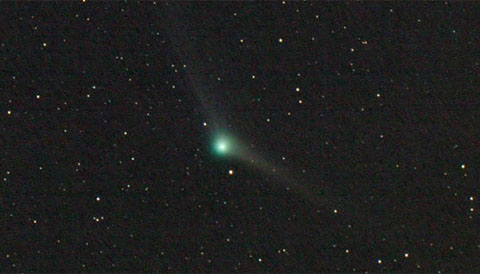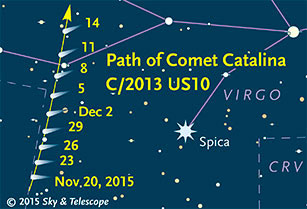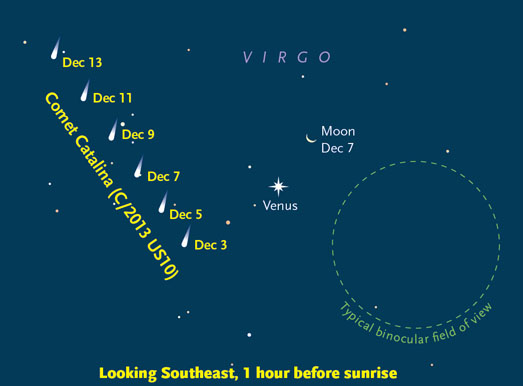Our current visitor from the Oort Cloud, rising into northern skies at last, can be glimpsed with binoculars low in the east before dawn. Spotting it will be especially easy on December 7th.
When it comes to spotting celestial objects before dawn, I'll admit to being an "observer of convenience." If I make the effort to get up that early, what I'm looking for had better be easy to find and appreciate. So expect to see me outside around 5 a.m. this coming week to check out Comet Catalina.

Chris Schur
The interloper's formal designation, C/2013 US10, tells us that we've been waiting for this visitor from the Oort Cloud to reach its peak for quite some time. It's got a steeply inclined, retrograde orbit, and as it approached perihelion (November 15th), the comet lingered in the southern sky, hidden from those of us well north of the equator. However, in the past two weeks it has climbed steadily in declination and can now be glimpsed low in the east at or just before the start of morning twilight.

Sky & Telescope diagram
Unfortunately, Comet Catalina hasn't lived up to early expectations that it would blossom to naked-eye visibility and peak at around 4th magnitude. While it is shining near 6th magnitude right now, this value assumes that all of the glow from its coma, reportedly a few arcminutes across, is concentrated into a single starlike point.
But let's be optimistic: while it's already heading away from the Sun, C/2013 US10 will continue to glide nearer to Earth until mid-January. Many observers report seeing it through binoculars, and recent photographs show thin, widely splayed gas and dust tails.
Now that the bright Moon has been reduced to a waning crescent, it's an excellent time to go comet-hunting. Start looking no later than an hour before dawn, by which time Comet Catalina has risen at least 15° above the southeast horizon. Use binoculars or a small, wide-field telescope — along with Sky & Telescope's detailed chart above — to locate it in the coming weeks.
Even without the chart, you can use dazzling Venus as a guide for spotting Comet Catalina, which is gliding upward to the planet's left during the next week. And if you only want to get up early once, circle next Monday, December 7th, on your calendar. On that morning, your target will be left of Venus and only 4½° away — they should both fit within the field of view of binouclars. What's more, the planet and comet will be joined by a lovely crescent Moon just four days from new. Snap some pictures, and then add your best effort to our online photo gallery.

Sky & Telescope diagram
With luck, C/2013 US10 will stay decently bright as it climbs higher into the sky. You'll be able to observe it Moon-free until late this month, and on New Year's morning Comet Catalina will be just ½° from Arcturus (and rises near midnight for far-northern observers — woo-hoo!). It passes closest to Earth, at a distance of 0.72 astronomical unit (108 million km) on January 12th, by which time it will be sailing past the Big Dipper's handle.
So you and I really have no excuse not to try to observe this comet. Give it a try, and let me know (via a comment below) what you find.
 11
11
Comments
December 5, 2015 at 10:51 am
This was my first attempt to get an image of the comet C/2013 US10 (Catalina). And my first attempt to ever take a photo of a comet. I got up a little early took some less than impressive photos at 5:45 am at the SHS parking lot. I will try for a better image with my telescope next month.
You must be logged in to post a comment.
Jorge Luis
December 5, 2015 at 4:11 pm
Hi Kelly, from my latitude 10 ° North (San Diego, Venezuela) and I could see with my binoculars 10x70 near k and syrma Star Virgo. excellent post. with mini reflector dob 76/300 FirstScope is recommended that eyepiece ? thanks...
You must be logged in to post a comment.
J. Kelly BeattyPost Author
December 6, 2015 at 9:54 pm
Hola, Jorge! I spotted it this morning in 10×50 binoculars. I found it, but only because I knew where to look. I didn't see any color -- how about you?
You must be logged in to post a comment.
December 6, 2015 at 9:51 am
Thank you Sky and Telescope and thank you Kelly for the information. I was up this morning just north of Boston to see the comet. From my site there was a nice green coma, but no tail. It's always nice to log in a new object.
Joe
You must be logged in to post a comment.
postrevolutionary
December 7, 2015 at 1:55 am
Kelly, thanks for the observing update. One concern, though — Sky and Telescope knows that the Oort Cloud is hypothetical — there's no proof of its existence. You should either include that fact or not mention the "cloud" at all.
You must be logged in to post a comment.
Michael Beckage
December 8, 2015 at 10:17 am
From my suburban location in Seal Beach CA the comet was easy to locate this morning with 10X42 IS Canon binoculars. The appearance was comparable to the brighter globular clusters like M22. Venus and the stars of Virgo are convenient guideposts right now. I am looking forward to imaging the comet from my dark sky location in Borrego Springs this weekend!
You must be logged in to post a comment.
Theo-Wellington
December 8, 2015 at 5:09 pm
Very difficult observation from light polluted Nashville. Shows up nicely in 5.5" newtonian, but just a dot in binoculars. Needed a good finder chart to decide which dot was comet. Need a power outage to my east! Will also move to dark skies.
You must be logged in to post a comment.
Jorge Luis
December 10, 2015 at 4:48 pm
Kelly Hello, my 10x70 equally observed not only a diffuse color and image ...
You must be logged in to post a comment.
December 10, 2015 at 5:43 pm
Caught a view of Comet Catalina at the beginning of morning twilight at about 6 AM fairly low in the southeastern sky on the morning of December 9, 2015 from the cemetery in Pecan Gap, Texas - about 100 miles to the northeast of my holiday residence in Arlington, Texas from whence I began my journey at about 3:45 AM to get a darker view to the southeast without having to look through that icon of light pollution otherwise known as the Dallas/Fort-Worth area.
Skies in Pecan Gap are four-ish on the Bortle scale, with a limiting magnitude of about 6.5. Pecan Gap's appeal lies in its having the closest and most easily-reachable patch of publicly-accessible land with skies so dark. And parts of the surrounding farmland are pretty at this time of year, making for an appealing exploratory excursion prior to the nightmarish drive along I-30 back to Dallas in the late morning, where one finds a textbook example of southern suburban blight most of the way.
I'd pulled over beside the road just outside of Commerce,Texas about a half-hour earlier just to be sure the drive with my 10" Dobsonian was worth continuing; from my spot beside the road I thought I could barely make out the comet using averted vision in the direction I understood the comet would be. Onward, I determined, to Pine Gap.
Upon my arrival (for my first visit) at the cemetery I hopped out with my binoculars and began scanning a patch of sky above and to the left of bright Venus, with the crescent moon basking in reflected earthshine well below. After about a minute of searching through my binoculars I made out a greenish smudge that had to be the comet given the lack of other deep-sky objects in that part of the heavens - no time to waste setting up the telescope now before the comet would be lost in the dawn twilight.
Accomplishing this relatively quickly despite my not having taken my telescope out of town in at least six months, I popped in a 2X-Barlowed 32mm eyepiece and began scanning the sky with my glorified soda-straw; it took a few minutes of focusing, searching, re-focusing and searching some more, but after having braced myself for disappointment I found it - a more-intense smudge of greenish light about a Telrad-diameter away from Venus. I'm hesitant to specify its magnitude but it was about as feint as the feintest deep-sky object I'd ever searched for and was still certain to have found albeit under slightly darker skies - I'd say it was about half as bright at most as M81 & M82 under Bortles-3 skies as seen from the nascent Palo Pinto State Park near Strawn, Texas, if that helps anyone. I couldn't distinguish any tail, just a light-green haze surrounding a slightly greener and brighter pinprick of a core. The sky was beginning to get medium-blue on the eastern horizon.
All in all the sight was worth the trip and I look for ward to checking out the comet more over the coming month as it arcs its way overhead in the morning sky on its way back out of the solar system.
You must be logged in to post a comment.
Ed in Arlington
December 13, 2015 at 10:51 am
PS - rank-amateur, seat-of-the-pants Catalina-spotters like myself may want to also observe nearby globular clusters M5, M10 and M12 nearby - to compare their similar brightnesses in comparison with that of Comet Catalina (and report that comparison here if possible?!), and - given that, as of this writing, M5 is only about one arc-hour away to the east in the next constellation over, Serpens Caput - to be sure that you have in fact found Comet Catalina and not mistaken M5, M10 yet another arc-hour-and-a-half away to the east or - egads - M12 ten arc-minutes still further east, for it.
You must be logged in to post a comment.
Ed in Arlington
December 16, 2015 at 6:22 pm
P. S. S. - To correct my previous remark: M10 is east of M12 by 10 arc-minutes; I'd reversed their locations previously herein.
You must be logged in to post a comment.
You must be logged in to post a comment.